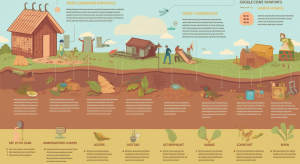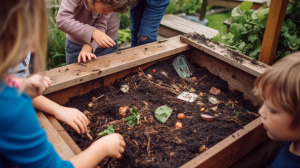Introduction to Composting: Basics of Composting
Composting 101 may seem like a daunting task for beginners, but in reality, it is just nature’s way of recycling. It is the process by which organic matter, including kitchen scraps, yard waste, and coffee grounds, is decomposed by microorganisms. This decomposition generates a nutrient-rich, organic material commonly referred to as compost, which can be used as a soil amendment in gardens or greenhouses. To start composting at home, one requires a dedicated area with ample space for a compost bin or pile. This zone could be your backyard, which could house either a purchased compost bin or a handmade bin, constructed from recyclable materials such as wire, wood, or sturdy plastic.
The process of composting involves adding food scraps and yard waste to your compost bin or pile. This mix should comprise an equal balance of brown material (like twigs, dried leaves, and grass clippings) which provide carbon, and green materials (including scraps of fruit and vegetables, eggshells, coffee grounds, and fresh lawn clippings) which supply nitrogen. It’s advisable to turn your compost regularly to aerate it and maintain a stable moisture level, speeding the decomposition process. Avoid adding pet waste or diseased plant materials to the compost, as these can introduce harmful pathogens. Composting is a great way to reduce waste, and over time, the compost pile will break down these materials into a rich, dark soil amendment known as finished compost. This can be used in your garden to enrich the soil, replacing the need for synthetic fertilizers and making use of what would otherwise end up in a landfill as solid waste.
Understanding The Importance: Benefits of Composting
 Understanding the importance of composting bears significant benefits to our environment and personal gardening practices.
Understanding the importance of composting bears significant benefits to our environment and personal gardening practices.
Composting represents a highly useful method of waste management, transforming organic waste typically disposed of in household garbage into a valuable resource.
The process involves the decomposition of organic materials like food waste and yard trimmings, which generate a nutrient-rich, fertile compost ready to bestow a garden. This method makes a substantial impact on the world’s waste reduction, as it curbs the significant amount of food waste we generate at home and diverts it towards composting facilities or backyard composting systems.
This beginner’s guide to composting emphasizes the advantages that come with participation in this environmentally friendly process. Composting can alleviate the emission of greenhouse gasses, often associated with large-scale composting methods that don’t control the composting process, and enables you to practice green living. Here’s how:
- The composting process primarily involves recycling organic waste, such as fruit and vegetable scraps from the kitchen, into compost. In doing so, it reduces the amount of waste reaching landfills, consequently minimizing the release of harmful gasses.
- Composting breaks down organic matter in a beneficial way. Using a compost bin or pile, materials break down into a substance that is very much like fertile garden soil. Active composting, such as hot composting, accelerates this process using controlled heat; alternatively, uses like cold composting require less management but more time.
- Composting needs no significant setup or investment. One can purchase a compost bin or make one using readily available materials. The system takes minimal space and is suitable for both indoor and backyard composting, depending on your preference.
- The compost is ready to use after a few weeks or months. As the compost material decomposes, you can harvest the lower layers, leaving the fresh layer to decompose further.
In essence, composting is a win-win, turning waste into a resource, reducing the impact on landfills, and helping plants grow healthier and stronger. Participating in your home composting or composting and recycling program can bring significant value to your garden composting and broader environmental practices. With this beginner’s guide, starting composting can be done today, joining this crucial global movement for sustainable waste management.
Step-by-Step Guide: How to Start Composting at Home
Starting a composting system at home can seem like a daunting task, but by following this step-by-step guide, you will be well on your way to transforming your household waste into nutrient-rich compost. First, select a spot in your yard where you can place the bin. Ensure it’s convenient so that adding material regularly isn’t a chore. It should ideally receive a mix of sun and shade to help maintain an optimal temperature of around 0.5 degrees; this is key in facilitating the breakdown of waste. Your compost bin or pile should be large enough to maintain a good amount of compost yet small enough to manage.
To get started, layer about 18 to 24 inches of compost at the bottom of the bin, preferably garden waste like leaves, grass clippings or twigs. This helps create an inviting environment for the microbes that break down organic materials. A key element of your composting program should include incorporating “green” materials (such as vegetable peels, and coffee grounds) with “brown” materials (such as dried leaves or newspaper). Remember, composting is nature’s way of recycling food and garden waste into compost. Here’s a tip: you can even place a worm bin indoors during the colder months.
Finally, ensure that you turn your compost pile regularly to encourage it to break down faster. With a well-managed system, you can turn your waste into finished compost in as little as two months.
Deep Dive Into Worm Composting: How to Use Worms for Composting at Home
 As a method of composting, using worms at home brings an exciting blend of benefits to your garden and also contributes positively to the environment. Worm composting, also known as vermiculture, is the process of using various species of worms, usually red wigglers, white worms, and earthworms, to create a rich, nutrient-dense compost from household waste.
As a method of composting, using worms at home brings an exciting blend of benefits to your garden and also contributes positively to the environment. Worm composting, also known as vermiculture, is the process of using various species of worms, usually red wigglers, white worms, and earthworms, to create a rich, nutrient-dense compost from household waste.
It’s an effective and environmentally friendly way to reduce food and garden waste while creating nutrient-rich compost for your plants. This composting is one of the easiest and most sustainable waste management methods that can be done right from the comfort of your own home.
Setting up a worm composting system at home begins with identifying the right location. This could be your garden, your home, or in a pile or bin. The location should be favorable to the worms, so it’s important to maintain a temperature of 15°C to 25°C to keep the worms thriving. Here is how to get started with setting up the worm bin:
- Add a layer of damp shredded paper or cardboard at the bottom of the bin.
- Introduce the worms to the pile or bin.
- Start adding your waste materials to your pile, ensuring that they are cut into small pieces to help the worms break down waste more effectively.
- Always cover the waste materials with a layer of paper or other worm-friendly bedding to control odor and flies.
It’s vital to note that not all kitchen waste is suitable for worm composting. Fruit scraps, vegetable scraps, and coffee grounds are suitable additions, but citrus peels, meat, dairy, and oily foods are not recommended. Regularly monitoring the conditions of the composting bin, ensuring it remains moist but not too wet, and avoiding overfeeding the worms are essential practices. The compost produced from worm composting, often referred to as worm castings, is highly nutritious and can be used to enrich garden soil, potted plants, or as a top dressing for your lawn.
By following these simple steps and being mindful of the compost’s conditions, you can efficiently turn kitchen and garden waste into a valuable resource, all while engaging in an environmentally sustainable practice. Worm composting not only enriches your soil but also provides an excellent opportunity to reduce household waste and contribute to a healthier environment.
Conclusion
Composting is one practical and nature-friendly method to manage organic waste. It primarily involves the process of letting organic matter biodegrade under controlled conditions. Implementing a method of composting is quite straightforward: it requires the use or creation of a pile or bin where you put your organic waste materials.
The pile or bin becomes a site where the breakdown of waste takes place through the activity of macro and microorganisms. These organisms, fueled by the right combination of moisture, warmth, and air, work on the organic waste to decompose it into nutrient-rich compost. This compost, when mixed with soil, greatly enhances its fertility and capacity to support plant growth.
Adding materials to your pile requires careful mindfulness; ensuring a balanced mix of green and brown ingredients, such as vegetable peelings and dried leaves, respectively, is highly beneficial. Green ingredients provide nitrogen, while brown ingredients provide carbon, collectively aiding in the composting process.
In conclusion, composting is an ecological way of recycling waste materials from your kitchen and garden. By utilizing a method of composting, especially through the usage of a pile or bin, we all can make a significant contribution to waste reduction and improving soil health, thus promoting a healthier and greener environment.
FAQ’s:
Q1. What is the method of composting?
A1. Composting is a method of breaking down organic waste into a nutrient-rich soil amendment.
Q2. Should I use a pile or bin for composting?
A2. Composting can be done in either a pile or a bin. The type of composting you choose will depend on the materials you add to your pile.
Q3. What materials can I add to my compost pile?
A3. You can add a variety of materials to your compost pile, including food scraps, yard waste, and paper products.
Q4. How does composting break down waste?
A4. Composting is one of the most efficient ways to break down organic waste. Microorganisms in the compost pile break down the waste into a nutrient-rich soil amendment.
Q5. What are the benefits of composting?
A5. Composting has many benefits, including reducing waste, improving soil health, and providing a natural fertilizer for plants.
Q6. How long does it take for compost to break down?
A6. The amount of time it takes for compost to break down depends on the materials added to the pile and the temperature of the compost pile. Generally, it takes several weeks to several months for compost to break down.
Q7. Is composting an eco-friendly recycling method?
A7. Yes, composting is an eco-friendly recycling method that helps reduce waste and improve soil health.

Nina Jerkovic
Meet Nina Jerkovic, our expert on all things green and sustainable. With a keen eye for eco-friendly living, Nina shares practical tips and insights to help you navigate the world of sustainable choices. Join her on a mission to create a healthier planet through mindful living.


 Energy Efficiency Incentives and Rebates
Energy Efficiency Incentives and Rebates
